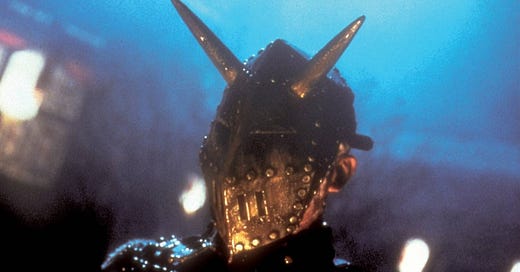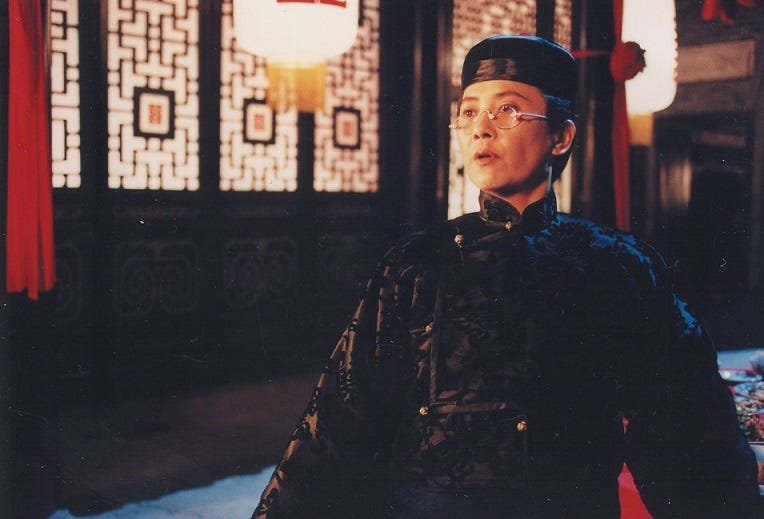Wong Jing’s The New Legend of Shaolin (1994) is a ground-breaking film for how it combines the martial arts and horror genres within the context of a children’s movie. This is one of the things that went over the heads of many detractors, especially his detractors. In fact, I would go as far to say that The New Legend of Shaolin is the best children's martial arts movie. It makes the American equivalents look pathetic. You might not think that is saying much because it sounds like a niche sub-genre, but there had been a long tradition of Chinese martial arts movies for children – Cunning Kids (1980), Kung Fu Kids Break Away (1980), 36 Super Kids (1982) and Lucky Seven (1986). Before I forget, there was the Kung Fu Kids quadrilogy from 1986 to 1987. Granted, these were Taiwanese movies rather than Hong Kong ones…but a Chinese movie is a Chinese movie.
As for nineties fare, almost nothing had been done since the 1989 release of Lucky Seven 2. Then came 1992: The Little Shaolin Monk and Kongfu Kids. Contrary to his usual practice of following a trend, Hong Kong filmmaker Wong Jing was instead instigating a trend. Kevin Chu Yen-Ping, a Taiwanese director, got wind of Wong Jing making a children's martial arts movie, and began work on a similar production albeit a modern one. Originally titled Shaolin Popeye, it was released as Shaolin Popey two weeks after Jing's movie had finished playing in H.K. cinemas. Shaolin Popey flopped in H.K. but it did such good business in Taiwan that it quickly instigated a sequel titled Shaolin Popey II: Messy Temple, which was released three months later (i.e. July of 1994). This then led to a spate of similar movies: The Shaolin Kids in Hong Kong (1994), Shaolin Kung Fu Kids (1995), Little Heroes Lost in China (1995) and 3 Kung Fu Kids (1996).
The villain in The New Legend of Shaolin is a mixture of two famous Freds – Freddy Krueger and Fred Flintstone. When you watch the movie, you will know what I mean. I don't want to spoil it for you because the unexpected is what makes a Wong Jing movie so fun to watch. What I will say is why he did this. A Nightmare on Elm Street (1984) and its sequels had their music cues pilfered by several H.K. film-makers for a handful of movies. As for Fred Flintstone, Wong Jing knew about Universal Pictures making a live-action adaptation of The Flintstones in the summer of 1993. Even while writing and producing Flying Dagger (a May 1993 release), Wong Jing knew that there could be mileage made from creating an ancient world where there are primitive versions of modern technology. In Flying Dagger, one of the characters is a fast-paced artist who is essentially working like a security camera.
Back to The New Legend of Shaolin, there's an allusion to Waxwork (1988). By far, the best in-joke is saved for last – an epic modification of the fatal silver spheres from Phantasm (another American horror movie whose soundtrack had been pillaged for many H.K. movies). The New Legend of Shaolin is also an unusual movie in that it could be considered as a threequel to two duologies. The Red Flower sect is a continuation of what was seen in the Fong Sai-Yuk duology i.e. the two 1993 movies starring Jet Li (the first movie even references Wong Jing). At the same time, The New Legend of Shaolin is special because Damian Lau regurgitates his character from Wong Jing’s Royal Tramp duology i.e. the two 1992 movies starring Stephen Chow (these movies were based on a 1969 novel).
There is a scene in The New Legend of Shaolin that lampooned the poisoned thread of wire gimmick in You Only Live Twice. Some critics had criticized Wong Jing for stealing this gag, but that idea was first done in a 1962 film called Ninja, a Band of Assassins. Speaking of which, The New Legend of Shaolin is one of those Chinese martial arts movies where you could get away with ignorantly retitling it so as to capitalize on the popularity of ninjas. Heck, it could have been retitled Shaolin Vs. Ninja II as a nifty reference to the 1983 movie directed by Robert Tai and starring Alexander Lo Rei. That is a Taiwanese martial arts movie, and it just so happens that The New Legend of Shaolin only got made because a Taiwanese investor wanted Wong Jing to make a movie about folklore heroes.
Back to Wong Jing’s imitative nature, there are some fairly hypocritical film critics who have a blindspot for their favourite filmmakers that makes them contradict themselves. The New Legend of Shaolin was accused by some haters for being a blatant knock-off of Lone Wolf and Cub (a 1972 Japanese film based on a manga series), but John Woo pretty much did the same thing with Heroes Shed No Tears (1983). Woo gets an easy ride because he made a serious war film. It should be noted that there were six entries of the seventies Lone Wolf and Cub film series - four installments in 1972, another in 1973, and the other in 1974. I like Wong Jing’s take on it because not only does it not seem contrived, but it allows Jing to make nods by comparing the ancient Chinese world with the Japanese equivalent.
Another case in point: Vincent Kok’s Forbidden City Cop (1996) gets an easy pass because it stars Stephen Chow. It has one scene that references two 1981 Kung Fu movies that Wong Jing had helped to write – Dreadnaught and The Prodigal Son. Both movies starred Yuen Biao whereas Forbidden City Cop was produced by Wong Jing. In spite of this, no-one ever accuses Vincent Kok and Stephen Chow of being rip-off merchant (since they both worked on the screenplay). The scene that I’m referring to combines the Yin-Yang illusion fight of Dreadnaught with the notorious Peking Opera assassination from The Prodigal Son.
I don’t want to spoil the former for you, so I will say no more than two words – dual duel. Why? Because the element of surprise is vital for an ambush scene, whether you’re making a martial arts movie or a horror movie. Dreadnaught was Wong Jing’s attempt at combining the Kung Fu and slasher genres, but his script had more deaths to rack up the suspense. This presents an amusing irony. The New Legend of Shaolin had recreated a signature fight scene from Dreadnaught (the tailor assassin gimmick), so Wong Jing was wrongly accused of plagiarism by many critics whereas nobody accused Ang Lee’s Crouching Tiger, Hidden Dragon (2000) for plainly plagiarizing plot points from The New Legend of Shaolin.
After The New Legend of Shaolin, writer Wong Jing would direct Jet Li one more time in High Risk (1995). It was symbolic for Kirk Wong to have been involved with that movie because his Cantonese name is Wong Chi-Keung, but his Mandarin name is Huang Zhi-Qiang. It's this latter name which provides the symbolism because it sounds like Hong Xiquan – the Mandarin name of Jet Li's character in The New Legend of Shaolin i.e. Hung Hei-Goon. A cameo would have allowed Kirk Wong to recreate some action beats from his modern films like arrows (bow or crossbow) used as a substitute for bullets. Perhaps he should have directed this movie too. Regardless, it’s the darkest collaboration between Jet Li and Wong Jing, especially since it mostly takes place at night. Unlike the summer vibe of Last Hero in China (due to the colour scheme if not the weather), The New Legend of Shaolin feels like a winter movie. It's the darkest children's martial arts movie, both literally and figuratively.
As for the fight scenes, the quality is so high that Corey Yuen Kwai was nominated for best action design at the 1995 Hong Kong Film Awards ceremony. I guess that the critics didn’t mind the lifting of ideas from earlier classic films. Corey Yuen is Jet Li’s number one collaborator but he didn’t always work on Jet’s collaborations with Wong Jing. First, Yuen Woo-Ping worked as the fight choreographer on Last Hero in China (1993) then Sammo Hung worked in this capacity on Kung Fu Cult Master (1993) before Corey picked up the reins on The New Legend of Shaolin. Besides working on High Risk, Corey directed My Father is a Hero (1995). This was not only written and produced by Wong Jing, but it had Jet Li team up with the same child actor who played his son in The New Legend of Shaolin - Tze Miu.
For Jet Li, starring in The New Legend of Shaolin was like peeking into an alternate reality – a road not taken regarding his film career. He had actually been offered film opportunities since the age of 11 in 1974. Jet Li had been rejected by one of the biggest Hong Kong movie managers for being too young, which is ironic considering the usage of child performers in films such as Sleeping Fist (1979) as well as Kids from Shaolin (a 1984 movie starring a 20-year-old Jet Li). Perhaps the manager was trying to spare Jet Li the painful truth of knowing how evil that the Chinese mafia can be. It never occured to me until now but it wouldn’t be a surprise if there have been things that happened in the H.K. film industry that are similar to the atrocities involving minors which took place in Hollywood.









